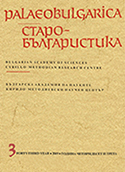Супрасълският сборник и старобългарските чети-минеи
Codex Suprasliensis and the Old Bulgarian Menologion
Author(s): Elka MirchevaSubject(s): Language studies, Language and Literature Studies
Published by: Кирило-Методиевски научен център при Българска академия на науките
Keywords: menologion; reading collections of menaion-panegyrical contents; Codex Suprasliensis; Preslav translations; literary center of Preslav; Slavia Orthodoxa
Summary/Abstract: Centuries separate the oldest collections in Slavic literature – the Codex Suprasliensis and Uspenskij sbornik – from the later collections of readings arranged according to the order of the church year. Among the latter, the oldest South Slavic menologia date from the 14th c. and the earliest Russian manuscripts date from the 15th c. The two groups are marked by clear typological differences. The article puts forward a hypothesis on the stages of the development of the this kind of literature in the Slavia Orthodoxa and outlines the main moments: 1. Translation of the brief panegyrico-martyrologion; 2. Appearance of menologia of the South Slavic type. The extant manuscripts show that they were essentially translations of a 6-, 4- or 3-month collection. The linguistic features reveal that the translation was made in Preslav; 3. Appearance of reading collections of menaion-panegyrical contents – the Codex Suprasliensis from the second half of the 10th c. With its readings for every day of March Supr follows the contents of a monthly volume of a 12-volume Byzantine menologion; 4. Appearance of menologia for one month. These are the so-called Russian menologia. The oldest are dated to the 15th c. The characteristic features of the Preslav translations, the typical Preslav lexis and the wide use of proto-Bulgarian words are proof of their Preslav origin. The comparison made between the March volume of МДА 92.2 and Supr reveals that 6 of the texts in Supr continue their existence in the menologia. Two of the texts in the March volume are representatives of the new Tarnovo redaction (structured according to the Jerusalem Typikon), and this means that they were included at a later stage. The number of new translations is significant. As compared with the translations in Supr they form a very interesting and significant group of double translations originating in Preslav. The two types of connections between Supr and МДА 92.2 outlined – continuity and inclusion of some translations from Supr in the menologia for a certain month on the one hand, and a redaction and a new translation of texts that had already been translated and included in Supr on the other – show Supr, a codex of the classical Old Bulgarian literature, to be a precursor of the menologion in Old Bulgarian literature. Towards the end of the 10th c., once again in a literary center connected with Preslav, the 12-volume Studite menologion was translated. Supr is not a menologion but I believe that it lays the beginnings of the menologion in Slavic literature. Continuity between Supr and the South Slavic literary tradition exists, but the witnesses for it are part of the East Slavic tradition. By virtue of the historic circumstances, which often predetermine the development of culture, 6-, 4- and 3-month menologia circulated in the South Slavic literatures. Their translation probably preceded that of the monthly reading collections and was once again connected with the literary center of Preslav.
Journal: PALAEOBULGARICA / СТАРОБЪЛГАРИСТИКА
- Issue Year: 2019
- Issue No: 3
- Page Range: 13-44
- Page Count: 32
- Language: Bulgarian
- Content File-PDF

